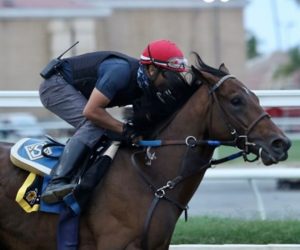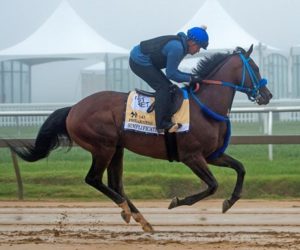After news broke late Thursday that a Kentucky Oaks horse tested positive for a Class C medical violation, Hall of Fame trainer Bob Baffert confirmed in a statement that his star filly, Gamine, was the culprit.

The New York Times, citing two sources, reported Thursday evening that Gamine tested positive for a Class C medication violation after her third-place finish as the 7/10 favorite in the Sept. 4 Oaks. The Kentucky Horse Racing Commission is forbidden from releasing the identity of horses with a positive drug test until its investigation is complete.
That investigation won’t be complete until testing on the split sample, or B-sample, is finished.
Not long after the Times report came out, Baffert confirmed through his attorney, W. Craig Robertson, that Gamine tested positive for betamethasone. That Class C drug is a corticosteroid used as an anti-inflammatory agent.
Dr. David Frisbie, an equine veterinarian at the Equine Orthopedic Center at Colorado State, told The Horse that betamethasone injections serve as a powerful painkiller because they alleviate inflammation in the joints.
Betamethasone Provides Short-Term Inflammation Relief
“Some corticosteroids are effective at abating this process,†Frisbie said. “Duration of pain relief is related to the degree of damage in the joint at the time of the treatment, as well as the particular medication used.â€
While acknowledging his star filly was the horse in question, Baffert and his team take issue with the result. Baffert’s statement, through Robertson, maintains that betamethasone is not a banned substance. It further states Gamine received the medication on Aug. 17 via her veterinarian, and according to his recommendation.
“Importantly, the veterinarian followed established medical and regulatory guidelines in administering the medication,†the statement read. “The withdrawal guidelines published by the Kentucky Horse Racing Commission recommend that the medication not be given within 14 days of a race. In this instance, as an additional layer of protection, Gamine’s veterinarian last treated her with betamethasone 18 days before the Oaks.â€
It Wasn’t the Drug. It Was the Amount
Where Gamine’s test was apparently flagged came with the amount. Robertson said her test displayed 27 picograms of betamethasone, nearly three times the KHRC’s limit of 10 picograms.
“The situation with Gamine highlights two issues that are very troubling and must be addressed by the racing industry,†the statement read. “First, the thresholds for many lawful medications such as betamethasone are way too low. A picogram is a trillionth of a gram. Twenty-seven pictograms is a minuscule amount that would not affect a 1,000-pound animal. The regulations governing racing must be ones that are related to pharmacology in a horse as opposed to how sensitive labs can test. Second, trainers and veterinarians must be able to rely on guidelines given them by racing officials. If they are told by regulators that a medication will clear a horse’s system in 14 days, they must be able to rely on that information.â€
If Robertson’s first argument questioning the effects of minuscule amounts of drugs in a horse sounds familiar, it should. This is the second time Gamine has apparently failed a drug test this year. In April, she was stripped of an Oaklawn Park allowance claiming victory. That came after her post-race drug test turned up nearly nine times the permitted amount of lidocaine. Baffert told reporters that came from a Salonpas back relief patch worn by assistant trainer Jimmy Barnes.
Two Strikes and Your Horse is Out
Baffert said Barnes handled the lidocaine-infused patch before administering tongue ties to Gamine and Arkansas Derby winner Charlatan. Both horses were disqualified after the B-samples confirmed the initial positive result.
Afterward, Robertson questioned how that tiny amount of lidocaine could affect a race.
“The trace levels of lidocaine found in both Charlatan and Gamine would have had no pharmacological effect, much less a performance-enhancing one on either horse. Zero,†Robertson told Bloodhorse.
Since her third-place Oaks finish, which came after two resounding Grade 1 stakes victories over the summer, Gamine has been training for the Breeders’ Cup Filly & Mare Sprint at Keeneland on Nov. 7.
The KHRC said no other samples showed any irregularities.











